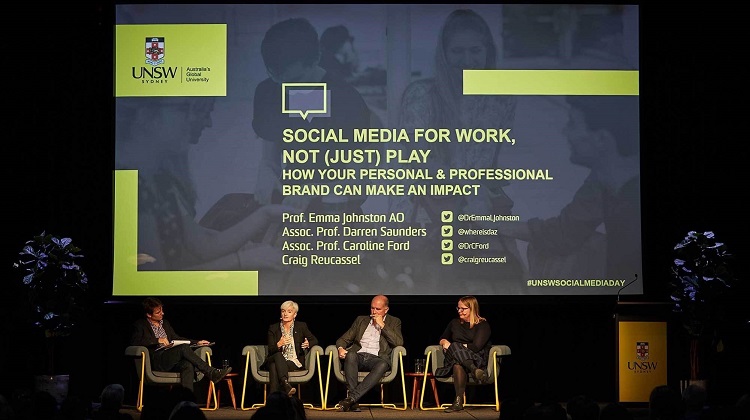
Connecting online through social media has become more important than ever in the era of physical distancing. Here are 10 reasons why getting social can work for you and promoting your research.
1. Social media helps drive citations
“The main reason that social media works is that it drives simple awareness of the work that you’re doing. Sure enough, you put your heart and soul into crafting that wonderful paper, the piece of work that you’ve published, but if nobody knows about it, it has very limited value beyond what you yourself have learned.”
Simon Kemp, Founder and CEO of Kepios
2. Twitter is key for tapping into new audiences to drive your research to the masses
“It has helped me build an academic profile to an enormous extent, engaging with conferences virtually just via the hashtags. You find your favourite conference, find the hashtag and literally you can see what talks are happening, who’s tweeting and start promoting your own research.”
Professor Emma Johnston AO, Dean of UNSW Science
3. Twitter is a fantastic tool for initiating collaborations
“Twitter breaks down that hierarchy that exists in academia. There are a lot of Nobel Laureates in that space, a lot of very important researchers doing cutting edge stuff and a lot of journal editors, so for me it’s been incredibly productive in terms of collaborations that have led to papers, joint funding and all that sort of stuff.”
Associate Professor Darren Saunders, UNSW Medicine
4. Twitter provides you with opportunities to connect with high-profile peers and mentors around the world
“My area is gynaecological cancers and there are a couple of really high-profile people in the United States and Europe. They tweet regularly, they’ll tweet their new papers, I’ll see it there, I’ll be able to comment on them and interact.
“It’s led to collaborations, it’s led to research reagents and things that are really unique that I’ve been able to ask them for via Twitter, where I’m fairly confident that if I had cold emailed them that they would not be so forthcoming. Because they understand me, they can quickly look at my profile, see that I’m in a similar field and that we have a shared purpose. So, it’s very useful.”
Associate Professor Caroline Ford, UNSW Medicine
5. Twitter can empower people who sometimes struggle to be heard
“Twitter is incredibly powerful for amplifying [the voice of] minority groups, particularly with women across STEMM.”
Associate Professor Caroline Ford, UNSW Medicine
6. The UNSW Social Media team can help you amplify your key research releases and thought leadership
“Make sure you @tag your faculty or the corporate brand (@unsw) whenever you’re posting about UNSW, because that way we can see it, and make sure that it gets a bigger audience.”
Jack Breen, Social Media Lead, Division of External Relations
7. Decide whether you want a professional, personal or hybrid approach for each of your social channels
“If you feel comfortable, UNSW encourages a hybrid personal and professional approach, as it makes you more authentic and relatable to your audiences. It really gives people the opportunity to tap into who you are. If you’re open and authentic, then it makes you credible and helps people relate to you, because you’re human, after all.”
Dan Wilkinson, Social Media Strategist
8. Make sure your content has a human element at its core
“The one fact that is universal across all the platforms and media is that people care about people and how your story will directly impact them.
“So you need to ask yourself some questions:
1. How will what you have to say impact people’s lives?
2. Who were the people involved in creating what you’re telling them about?
3. Is there something remarkable about what you’ve done?
“You need to identify that most interesting human element to what you’ve achieved and really make that your focus.”
Rae Johnston, Editor of Junkee
9. Consider four key principles when creating or requesting video content
• Is there an audience?
• Is it an interesting story?
• Is it visual?
• Is it unique?
“The more you know your audience, the more you’ve thought about telling the story in an interesting way, what kind of visual content we could include, and how unique this video will be, the better.”
Jake Willis, Creative Director of Pulse, Division of External Relations
10. Social media is important, even if your research area is niche
“You never know what you don’t know. Big audiences should never be a dirty word. We all want scale, but it’s the type of audience you’re seeking to attract. Traditionally mass media was a mile wide and an inch deep in terms of its penetration, but increasingly I think – and this is particularly influenced by my experience at UNSW – the audiences that we’re sometimes trying to reach are an inch wide and a mile deep in terms of super rich engagement. You don’t know who is going to be a co-collaborator or advocate of your research unless you start to dive into some of these areas.”
Darren Goodsir, Chief Communications Officer, Division of External Relations
- Log in to post comments
